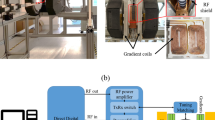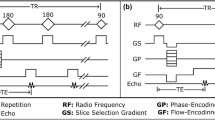Abstract
Objectives
Dental MRI is often impaired by artefacts due to metallic dental materials. Several sequences were developed to reduce susceptibility artefacts. Here, we evaluated a set of sequences for artefact reduction for dental MRI for the first time.
Methods
Artefact volume, signal-to-noise ratio (SNR) and image quality were assessed on a 3-T MRI for pointwise encoding time reduction with radial acquisition (PETRA), multiple-slab acquisition with view angle tilting gradient, based on a sampling perfection with application-optimised contrasts using different flip angle evolution (SPACE) sequence (MSVAT-SPACE), slice-encoding for metal-artefact correction (SEMAC) and compared to a standard SPACE and a standard turbo-spin-echo (TSE) sequence. Field-of-view and acquisition times were chosen to enable in vivo application. Two implant-supported prostheses were tested (porcelain fused to metal non-precious alloy and monolithic zirconia).
Results
Smallest artefact was measured for TSE sequences with no difference between the standard TSE and the SEMAC. MSVAT-SPACE reduced artefacts about 56% compared to the standard SPACE. Effect of the PETRA was dependent on sample used. Image quality and SNR were comparable for all sequences except PETRA, which yielded poor results.
Conclusion
There is no benefit in terms of artefact reduction for SEMAC compared to standard TSE. Usage of MSVAT-SPACE is advantageous since artefacts are reduced and higher resolution is achieved.
Key Points
• SEMAC is not superior to TSE in terms of artefact reduction.
• MSVAT-SPACE reduces susceptibility artefacts while maintaining comparable image quality.
• PETRA reduces susceptibility artefacts depending on material but offers poor image quality





Similar content being viewed by others
Abbreviations
- CBCT:
-
Cone beam computed tomography
- MDCT:
-
Multi-detector computed tomography
- MSVAT-SPACE:
-
Multiple-slab acquisition with VAT gradient, based on a SPACE sequence
- PETRA:
-
Pointwise encoding time reduction with radial acquisition
- RF:
-
Radio frequency
- ROI:
-
Region of interest
- SEMAC:
-
Slice-encoding for metal artefact correction
- SNR:
-
Signal-to-noise ratio
- SPACE:
-
Sampling perfection with application-optimised contrasts using different flip angle evolution
- TSE:
-
Turbo-spin-echo sequence
- UTE:
-
Ultrashort time of echo sequence
- VAT:
-
View angle tilting
- WIP:
-
Work in progress
References
Vandenberghe B, Jacobs R, Bosmans H (2010) Modern dental imaging: a review of the current technology and clinical applications in dental practice. Eur Radiol 20:2637–2655
Patel S, Dawood A, Ford TP, Whaites E (2007) The potential applications of cone beam computed tomography in the management of endodontic problems. Int Endod J 40:818–830
Gahleitner A, Watzek G, Imhof H (2003) Dental CT: imaging technique, anatomy, and pathologic conditions of the jaws. Eur Radiol 13:366–376
Abrahams JJ (2001) Dental CT imaging: a look at the jaw 1. Radiology 219:334–345
Monsour P, Dudhia R (2008) Implant radiography and radiology. Aust Dent J 53(Suppl 1):25
Claus E, Calvocoressi L, Bondy M, Schildkraut J, Wiemels J, Wrensch M (2012) Dental x-rays and risk of meningioma. Cancer 118:4530–4537
Liang X, Lambrichts I, Sun Y et al (2010) A comparative evaluation of cone beam computed tomography (CBCT) and multi-slice CT (MSCT). Part II: On 3D model accuracy. Eur J Radiol 75:270–274
Eggers G, Rieker M, Kress B, Fiebach J, Dickhaus H, Hassfeld S (2005) Artefacts in magnetic resonance imaging caused by dental material. MAGMA 18:103–111
Ai T, Padua A, Goerner F et al (2012) SEMAC-VAT and MSVAT-SPACE sequence strategies for metal artifact reduction in 1.5T magnetic resonance imaging. Investig Radiol 47:267–276
Lee YH, Lim D, Kim E, Kim S, Song HT, Suh JS (2013) Usefulness of slice encoding for metal artifact correction (SEMAC) for reducing metallic artifacts in 3-T MRI. Magn Reson Imaging 31:703–706
Sutter R, Ulbrich EJ, Jellus V, Nittka M, Pfirrmann CW (2012) Reduction of metal artifacts in patients with total hip arthroplasty with slice-encoding metal artifact correction and view-angle tilting MR imaging. Radiology 265:204–214
Cho ZH, Kim DJ, Kim YK (1988) Total inhomogeneity correction including chemical shifts and susceptibility by view angle tilting. Med Phys 15:7–11
Zho S-Y, Kim M-O, Lee K-W, Kim D-H (2013) Artifact reduction from metallic dental materials in T1-weighted spin-echo imaging at 3.0 tesla. J Magn Reson Imaging 37:471–478
Penarrocha Diago M, Boronat Lopez A, Lamas Pelayo J (2006) Update in dental implant periapical surgery. Med Oral Patol Oral Cir Bucal 11:E429–E432
Li G, Nittka M, Paul D, Lauer L (2011) MSVAT-SPACE for fast metal implants imaging. Proc Intl Soc Mag Reson Med 19:3171
Grodzki D, Jakob P, Heismann B (2012) Ultrashort echo time imaging using pointwise encoding time reduction with radial acquisition (PETRA). Magn Reson Med 67:510–518
Klinke T, Daboul A, Maron J et al (2012) Artifacts in magnetic resonance imaging and computed tomography caused by dental materials. PLoS One 7:e31766
Imai H, Tanaka Y, Nomura N et al (2013) Three-dimensional quantification of susceptibility artifacts from various metals in magnetic resonance images. Acta Biomater 9:8433–8439
Dietrich O, Raya JGG, Reeder SB, Reiser MF, Schoenberg SO (2007) Measurement of signal-to-noise ratios in MR images: influence of multichannel coils, parallel imaging, and reconstruction filters. J Magn Reson Imaging 26:375–385
Friedman L, Glover GH (2006) Report on a multicenter fMRI quality assurance protocol. J Magn Reson Imaging 23:827–839
Landis J, Koch G (1977) An application of hierarchical kappa-type statistics in the assessment of majority agreement among multiple observers. Biometrics 33:363–374
Eley KA, Watt-Smith SR, Golding SJ (2013) "Black Bone" MRI: a potential non-ionizing method for three-dimensional cephalometric analysis–a preliminary feasibility study. Dentomaxillofac Radiol 42:20130236
Tymofiyeva O, Rottner K, Jakob PM, Richter EJJ, Proff P (2010) Three-dimensional localization of impacted teeth using magnetic resonance imaging. Clin Oral Investig 14:169–176
Kress B, Buhl Y, Hähnel S, Eggers G, Sartor K, Schmitter M (2007) Age- and tooth-related pulp cavity signal intensity changes in healthy teeth: a comparative magnetic resonance imaging analysis. Oral Surg Oral Med Oral Pathol Oral Radiol Endod 103:134–137
Tymofiyeva O, Rottner K, Gareis D et al (2008) In vivo MRI-based dental impression using an intraoral RF receiver coil. Concepts Magn Reson 33B:244–251
Schara R, Sersa I, Skaleric U (2009) T1 relaxation time and magnetic resonance imaging of inflamed gingival tissue. Dentomaxillofac Radiol 38:216–223
Tartaglino LM, Flanders AE, Vinitski S, Friedman DP (1994) Metallic artifacts on MR images of the postoperative spine: reduction with fast spin-echo techniques. Radiology 190:565–569
Hargreaves B, Worters P, Pauly K, Pauly J, Koch K, Gold G (2011) Metal-induced artifacts in MRI. AJR Am J Roentgenol 197:547–555
Viano A, Gronemeyer S, Haliloglu M, Hoffer F (2000) Improved MR imaging for patients with metallic implants. Magn Reson Imaging 18:287–295
Cox RJ, Kau CH, Rasche V (2012) Three-dimensional ultrashort echo magnetic resonance imaging of orthodontic appliances in the natural dentition. Am J Orthod Dentofacial Orthop 142:552–561
Carl M, Koch K, Du J (2012) MR imaging near metal with undersampled 3D radial UTE-MAVRIC sequences. Magn Reson Med 69:27–36
Acknowledgements
TH receives funding from a postdoctoral fellowship of the Medical Faculty of the University of Heidelberg. The authors would like to thank Stefanie Sauer, PhD, a pharmacist at the Department of Pharmacy, Heidelberg University Hospital, for her contribution to the MRI phantom. Furthermore, we would like to thank NORAS MRI products GmbH, especially Daniel Gareis, MSc, for providing a prototype of the 16-channel multipurpose coil.
Author information
Authors and Affiliations
Corresponding author
Ethics declarations
Guarantor
The scientific guarantor of this publication is Dr. rer. nat. Sabine Heiland.
Conflict of interest
The authors of this manuscript declare relationships with the following companies: Siemens Healthcare GmbH and NORAS MRI products GmbH. The co-authors M.Nittka, PhD, and D.Grodzki, PhD, are employees of Siemens Healthcare GmbH and were involved in the technical development of the metal-artefact-reducing pulse sequences.
Funding
The study was supported in part by the Dietmar-Hopp-Stiftung (project no 23011228).
Statistics and biometry
No complex statistical methods were necessary for this paper.
Informed consent
Informed consent was not required since no living animals were studied.
Ethical approval
Institutional review board approval was not required since no living animals were studied.
Methodology
• Prospective
• experimental
• performed at one institution
Rights and permissions
About this article
Cite this article
Hilgenfeld, T., Prager, M., Heil, A. et al. PETRA, MSVAT-SPACE and SEMAC sequences for metal artefact reduction in dental MR imaging. Eur Radiol 27, 5104–5112 (2017). https://doi.org/10.1007/s00330-017-4901-1
Received:
Revised:
Accepted:
Published:
Issue Date:
DOI: https://doi.org/10.1007/s00330-017-4901-1




